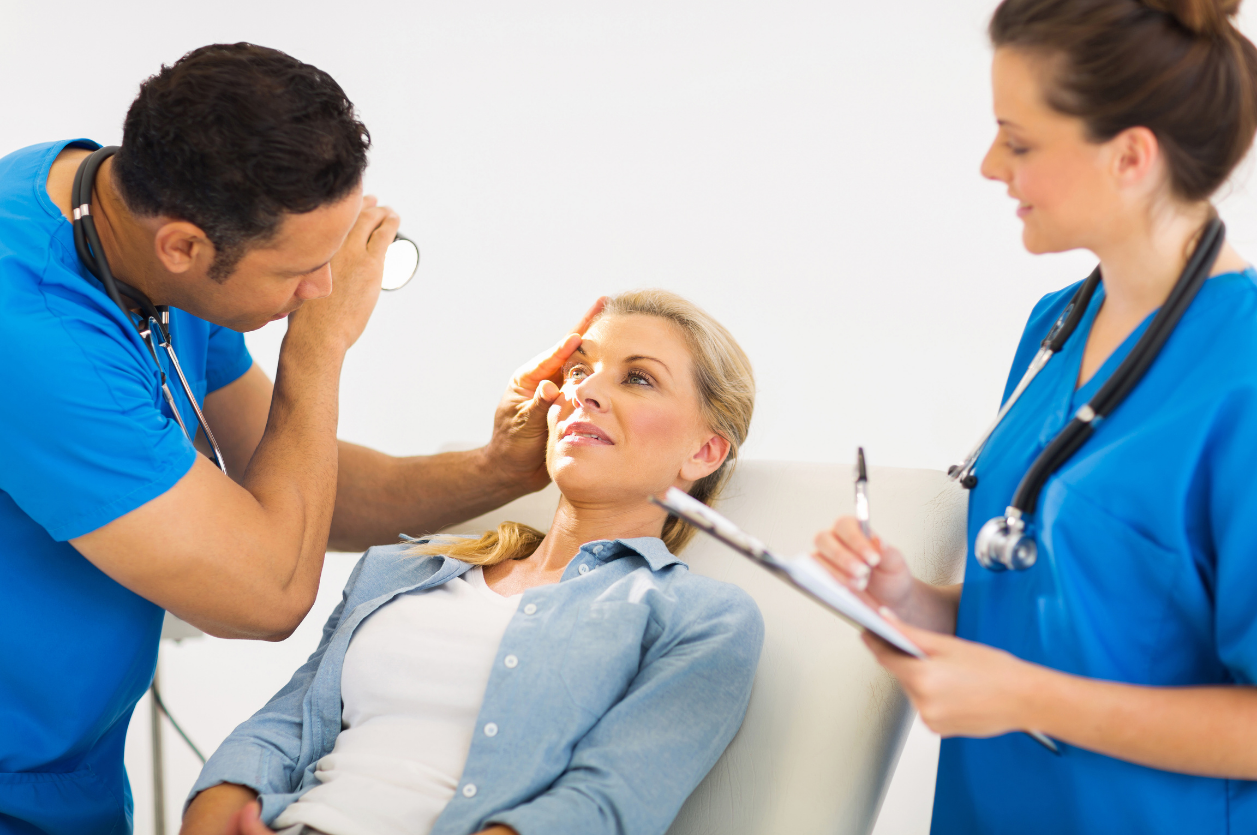Signs and Symptoms of Age-Related Macular Degeneration
Age-related macular degeneration (AMD) is the leading cause of vision loss—more than cataracts and glaucoma together—and affects more than 10 million people in the U.S., according to the American Macular Degeneration Foundation.
 AMD is caused by the deterioration of the central portion of the retina. In basic terms, the retina records the images the eye sees and then sends those images through the optic nerve to be processed by the brain. The central portion of the retina is the macula, which is responsible for focusing central vision in the eye. This controls the ability to recognize faces and colors, read and see objects in fine detail.
AMD is caused by the deterioration of the central portion of the retina. In basic terms, the retina records the images the eye sees and then sends those images through the optic nerve to be processed by the brain. The central portion of the retina is the macula, which is responsible for focusing central vision in the eye. This controls the ability to recognize faces and colors, read and see objects in fine detail.
Vision is affected when the cells of the macula begin to deteriorate. This means images aren’t received correctly in the brain. In its early stage, AMD doesn’t affect vision. As the disease progresses, however, one might experience wavy or blurred vision. And if it continues to progress, the central vision may be completely lost. Those with very advanced macular degeneration are considered legally blind.
It’s important to note that AMD does not affect peripheral (side) vision.
What signs and symptoms of AMD should you watch out for?
Two Types of AMD
There are two basic types of AMD, dry and wet. All AMD starts as dry, but some cases develop into wet AMD. Overall, about 85-90% of cases are the dry type, and 10-15% are the wet type.
While the two types have similar symptoms, there are some important differences.
Dry AMD
Dry AMD has pain-free symptoms that develop gradually, and it usually affects both eyes. If you have it in only one eye, your “good” eye can compensate, which means you might not notice any symptoms. This highlights the importance of regular eye exams.
Symptoms of dry AMD include:
- visual distortions, like seeing straight lines as bent.
- decreased central vision in one or both eyes.
- needing brighter light when reading or doing close work.
- problems adapting to low light levels, such as those in a dimly lit room.
- increased blurriness of printed words.
- diminished intensity or brightness of colors.
- problems recognizing faces.
Dry AMD can progress to wet (neovascular) macular degeneration, which is when the blood vessels that grow under the retina leak. It usually progresses over years.
Wet AMD
Wet AMD is generally caused by abnormal blood vessels that leak fluid or blood into the macula.
Since wet AMD always begins as dry, early detection and treatment of AMD is critical. If wet AMD is diagnosed, early detection can help curb vision loss and, in some cases, recover vision.
Wet AMD symptoms usually appear suddenly and rapidly worsen. They include:
- visual distortions, like seeing straight lines as bent.
- decreased central vision in one or both eyes.
- diminished intensity or brightness of colors.
- a well-defined blurry spot or blind spot in your field of vision.
- a general haziness in your overall vision.
- a quick onset and rapidly worsening symptoms.
The exact cause of wet AMD is unknown, but it develops in some people who have had dry macular degeneration.
It can develop in a couple of different ways:
- Abnormal blood vessel growth. When abnormal blood vessels leak fluid or blood, it interferes with the retina's function. These blood vessels grow from the choroid (the layer of blood vessels between the retina and the outer, firm coat of the eye).
- Fluid buildup in the back of the eye. When fluid leaks from the choroid, it can collect and may cause a bump in the macula, resulting in vision loss or distortion.
Risk Factors for AMD
Things that can increase your likelihood of developing AMD are:
- Age. AMD is most common in people over 50.
- Family history. There is a hereditary component to macular degeneration, and researchers have identified several genes related to developing it.
- Race. Macular degeneration is more common in Caucasians.
- Smoking. If you smoke cigarettes or are regularly exposed to smoke, your risk of developing AMD is significantly increased.
- Obesity. Being obese increases the chance that AMD will progress to a more severe form of the disease.
- Cardiovascular disease. Diseases that affect your heart and blood vessels may put you at a higher risk of AMD.
Treating AMD
Nutritional therapy is usually the treatment for early dry AMD, with a diet that’s both healthy and high in antioxidants to support the cells of the macula.
When AMD is further advanced but still dry, supplements are prescribed that may increase healthy pigments and support cell structure.
For wet AMD, the most common treatment is anti-vascular endothelial growth factor (anti-VEGF). This involves a periodic injection into the eye and has proven to be effective in slowing the disease progression.
Usually, VEGF is a helpful molecule to grow new blood vessels, but in macular degeneration, VEGF is unhealthy because it promotes the growth of new, weak blood vessels that leak blood, fats and serum into the layers of your retina. This leakage causes scarring in the retina and kills macular cells.
A shot of an anti-VEGF drug inhibits the formation of new blood vessels behind the retina. If an injection in the eye sounds scary, it isn’t painful because the eye has been anesthetized, but it may take several treatments for you to become used to the procedure. The effect may last for a month or longer.
Preventing AMD
It's very important to have routine eye exams to identify early signs of AMD. There are also steps you can take that may help reduce your risk of developing wet macular degeneration:
- Take care of other medical conditions. For example, if you have heart disease or high blood pressure, control your condition by taking your medication and following your doctor’s orders for your condition.
- Don't smoke. Ask your doctor for help to stop smoking, if necessary.
- Get regular exercise and maintain a healthy weight. Reduce the number of calories you eat and increase the amount of exercise you get if you need to lose weight.
- Eat a healthy diet. Make sure to include fruits, leafy greens, nuts, and fish high in omega-3 fatty acids, like salmon.
Visit Vision Source Plano for Early AMD Detection
As you’ve learned, the earlier AMD is caught, the better, so don’t put off your eye exam!
At Vision Source Plano, our individualized approach to optometry makes Dr. Malone and staff the eye and vision care providers of choice in the Plano area. We offer the following services:
- Complete eye exams
- Contact lenses and glasses
- Glaucoma testing
- Pre/post-operative care
- Dry eye treatment and diagnosis
We also work with other practitioners in the control and treatment of diabetic eye disease.
We offer financing options and work with your vision insurance provider to ensure the best in eye health and vision care.
For a complete list of services, visit our services page or call our Plano office at (972) 612-2099.
At Vision Source Plano, we are dedicated to providing high-quality optometry services in a comfortable environment.
Call us at (972) 612-2099, or schedule an appointment online today.
Disclaimer: The content on this blog is not intended to be a substitute for professional medical advice, diagnosis, or treatment. Always seek the advice of qualified health providers with questions you may have regarding medical conditions.








